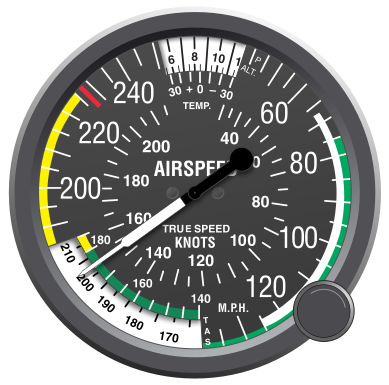Ask The CFI: Pitch or Power For Airspeed?
3/2/2016
Posted in
Flight Training
Tags: pitch for airspeed, power for altitude.

Whether we should control the airspeed of our aircraft by using pitch or power is a hotly debated topic in the flight training community. One school of thought is that we should use power for adjusting our airspeed, the other thinks that pitch should be used to control our airspeed. While it might be instinctual to use power to increase our speed like we do in nearly all other motorized vehicles, I am going to outline why in my experience as a flight instructor and pilot, that it is easier to understand and control our aircraft's speed using pitch, not power.
Ask The CFI: Pitch or Power For Airspeed?
written by Jacob Kasrpzyk Gold Seal CFI, CFII, MEI, ATP
We all know that airspeed control is vital in safely controlling our aircraft. Maintaining a proper airspeed helps insure a safer flight. Your instructor has likely taught you that the first step to a good landing is a good approach. To establish a good approach, we need to have proper airspeed control. Properly maintaining our airspeed on take-off will help us more quickly clear obstacles and gain us the most altitude as quickly as possible. In any emergency having more time to deal with the situation is a good thing. There are a lot of things we can do to lose time in the air, there are not a lot of things we can do to gain time! Understanding the fundamentals of controlling your aircraft's speed is vital in ensuring you have the maximum amount of time to deal with your situation.
Whether we should control the airspeed of our aircraft by using pitch or power is a hotly debated topic in the flight training community. One school of thought is that we should use power for adjusting our airspeed, the other thinks that pitch should be used to control our airspeed. While it might be instinctual to use power to increase our speed like we do in nearly all other motorized vehicles, I am going to outline why in my experience as a flight instructor and pilot, that it is easier to understand and control our aircraft's speed using pitch, not power.
First, lets think about how we control our aircraft under full power, like on a take-off. Your instructor has probably taught you that on take-off you should apply full throttle to generate maximum thrust for take-off. This will give you the shortest ground roll and also the fastest rate of climb after take-off. This will keep you further away from obstacles and will grant you more time to deal with an emergency if one unfortunately occurs. You were hopefully taught to climb at your Vx if there is an obstacle present or at Vy if there isn't. But, under full power, how do you obtain your Vx or Vy? You pitch for that airspeed. By pulling back on the yoke/stick, you decrease your airspeed and by pushing forward on the yoke/stick you increase your airspeed.
Now lets think about what happens when you have no power, like during an engine failure. How do you control your airspeed? You were hopefully taught that during an engine failure you should run through your 'ABCs' (Airspeed, Best field to land, Checklists, Communicate). The very first thing that you should do is to obtain your best glide airspeed. This will grant you the most time in the air and provide you with the most options and time to deal with your emergency. So how do you obtain your best glide speed with no power? You pitch your aircraft for the appropriate airspeed.
So at full power you control your airspeed with pitch and at no power you control your airspeed with pitch. It makes sense that at a power setting somewhere in between you would also use pitch to control your airspeed.
Next, lets think about flying your aircraft in straight and level, unaccelerated flight with the aircraft properly trimmed. What happens if you take your hands off the controls and reduce power? The aircraft will descend, not slow down. Matter of fact, it will maintain the exact same airspeed, but it will now be in a descent! What happens if you add power while in straight and level flight? The aircraft will pitch up and climb, not increase it's airspeed!
Now lets again think about the aircraft in straight and level, unaccelerated flight with the aircraft properly trimmed. But, this time instead of changing the power, we adjust the pitch. If we pitch the aircraft nose down while maintaining our current configuration and power setting, the aircraft will accelerate everytime! If we pitch up the aircraft will decelerate everytime!
Well what about if we wanted to increase our airspeed in level cruise flight? We need to add power right? While that is true, you also need to adjust your pitch. To increase your airspeed in level flight you will need to increase your power, but in doing so the aircraft will want to climb. To prevent the aircraft from climbing, you need to pitch the nose down! Again, you are pitching down to increase your airspeed! The same applies if you wanted to decrease your airspeed in level flight. By reducing power, the aircraft will want to descend. To prevent it from descending, you will need to increase the pitch, decelerating the aircraft.
In conclusion, knowing how to properly control your aircraft will make you a safer pilot. Hopefully this article has helped you understand why using pitch to control your airspeed and power for your altitude is a simpler way of doing things.
We would love to hear your thoughts on the subject! Feel free to comment below to continue the discussion!
Safe Flying!